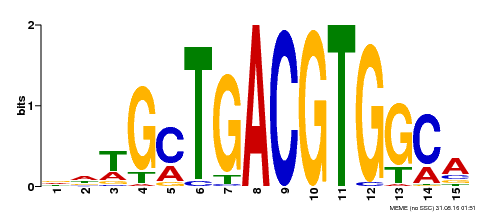 |
PlantRegMap/PlantTFDB v5.0
Plant Transcription
Factor Database
|
| Home TFext BLAST Prediction Download Help About Links PlantRegMap |
Transcription Factor Information
| Basic Information? help Back to Top | |||||||||
|---|---|---|---|---|---|---|---|---|---|
| TF ID | XP_015891704.1 | ||||||||
| Organism | |||||||||
| Taxonomic ID | |||||||||
| Taxonomic Lineage |
cellular organisms; Eukaryota; Viridiplantae; Streptophyta; Streptophytina; Embryophyta; Tracheophyta; Euphyllophyta; Spermatophyta; Magnoliophyta; Mesangiospermae; eudicotyledons; Gunneridae; Pentapetalae; rosids; fabids; Rosales; Rhamnaceae; Paliureae; Ziziphus
|
||||||||
| Family | bZIP | ||||||||
| Protein Properties | Length: 146aa MW: 16518.8 Da PI: 9.1347 | ||||||||
| Description | bZIP family protein | ||||||||
| Gene Model |
|
||||||||
| Signature Domain? help Back to Top | |||||||
|---|---|---|---|---|---|---|---|
| No. | Domain | Score | E-value | Start | End | HMM Start | HMM End |
| 1 | bZIP_1 | 40.3 | 7e-13 | 22 | 72 | 5 | 55 |
CHHHCHHHHHHHHHHHHHHHHHHHHHHHHHHHHHHHHHHHHHHHHHHHHHH CS
bZIP_1 5 krerrkqkNReAArrsRqRKkaeieeLeekvkeLeaeNkaLkkeleelkke 55
++ +r+ +NRe+ArrsR RK++++e L+ +v +Le N +L++ ++ +++
XP_015891704.1 22 RKRKRMLSNRESARRSRMRKQKQLEDLTSEVSQLEIANNQLRQSINAKEQT 72
57899*************************************999987765 PP
| |||||||
| Protein Features ? help Back to Top | ||||||
|---|---|---|---|---|---|---|
| Database | Entry ID | E-value | Start | End | InterPro ID | Description |
| SMART | SM00338 | 5.6E-14 | 18 | 82 | IPR004827 | Basic-leucine zipper domain |
| Gene3D | G3DSA:1.20.5.170 | 3.3E-11 | 19 | 70 | No hit | No description |
| PROSITE profile | PS50217 | 10.829 | 20 | 67 | IPR004827 | Basic-leucine zipper domain |
| SuperFamily | SSF57959 | 1.48E-11 | 22 | 75 | No hit | No description |
| Pfam | PF00170 | 7.2E-11 | 22 | 69 | IPR004827 | Basic-leucine zipper domain |
| CDD | cd14702 | 6.09E-17 | 23 | 73 | No hit | No description |
| PROSITE pattern | PS00036 | 0 | 25 | 40 | IPR004827 | Basic-leucine zipper domain |
| Gene Ontology ? help Back to Top | ||||||
|---|---|---|---|---|---|---|
| GO Term | GO Category | GO Description | ||||
| GO:0006971 | Biological Process | hypotonic response | ||||
| GO:0009267 | Biological Process | cellular response to starvation | ||||
| GO:0045893 | Biological Process | positive regulation of transcription, DNA-templated | ||||
| GO:2000693 | Biological Process | positive regulation of seed maturation | ||||
| GO:0005634 | Cellular Component | nucleus | ||||
| GO:0003700 | Molecular Function | transcription factor activity, sequence-specific DNA binding | ||||
| GO:0043565 | Molecular Function | sequence-specific DNA binding | ||||
| GO:0046982 | Molecular Function | protein heterodimerization activity | ||||
| Sequence ? help Back to Top |
|---|
| Protein Sequence Length: 146 aa Download sequence Send to blast |
MASMQRPTSS GSDGSAASID ERKRKRMLSN RESARRSRMR KQKQLEDLTS EVSQLEIANN 60 QLRQSINAKE QTFIHVESAN NVLRAQAMEL TDRLRSLNSV LQIVEDVSGL MVDIPEIPEI 120 ADPLLKPWQV PYTTHPITAS ADMFLR |
| Nucleic Localization Signal ? help Back to Top | |||
|---|---|---|---|
| No. | Start | End | Sequence |
| 1 | 21 | 42 | RKRKRMLSNRESARRSRMRKQK |
| 2 | 34 | 41 | RRSRMRKQ |
| Functional Description ? help Back to Top | ||||||
|---|---|---|---|---|---|---|
| Source | Description | |||||
| UniProt | Transcription activator that binds DNA to the C-box-like motif (5'-TGCTGACGTCA-3'), ABRE elements, G-box-like motif (5'-CCACGTGGCC-3'), DOF (5'-AAAG-3'), I-box (5'-GATAA-3'), BS1 (5'-AGCGGG-3'), MY3 (5'-CGACG-3'), 5'-CAGTGCGC-3' and 5'-ACTCAT-3' sequence in target gene promoters (PubMed:15047879, PubMed:16810321, PubMed:19531597, PubMed:21278122, PubMed:25108460). DNA-binding and subsequent transcription activation is triggered by heterodimerization with other bZIP proteins (e.g. BZIP1, BZIP10 and BZIP25) (PubMed:16810321, PubMed:19531597, PubMed:21278122). Promotes POX1/PRODH1 expression in response to hypoosmolarity stress (PubMed:15047879, PubMed:16810321). Transcriptional activator of seed maturation (MAT) genes (e.g. AT2S2), including seed storage protein (SSP) and late embryogenesis abundant (LEA) genes (PubMed:19531597). Activated by low energy stress both by transcriptional and post-transcriptional mechanisms. Promotes dark-induced senescence and participates in the transcriptional reprogramming of amino acid metabolism during the dark-induced starvation response, especially when heterodimerized with BZIP1, by triggering accumulation of sepcific proteins including ASN1 and POX1/PRODH1 (PubMed:21278122). {ECO:0000269|PubMed:15047879, ECO:0000269|PubMed:16810321, ECO:0000269|PubMed:19531597, ECO:0000269|PubMed:21278122, ECO:0000269|PubMed:25108460}. | |||||
| Binding Motif ? help Back to Top | |||
|---|---|---|---|
| Motif ID | Method | Source | Motif file |
| MP00419 | DAP | Transfer from AT3G62420 | Download |

| |||
| Cis-element ? help Back to Top | |
|---|---|
| Source | Link |
| PlantRegMap | XP_015891704.1 |
| Regulation -- Description ? help Back to Top | ||||||
|---|---|---|---|---|---|---|
| Source | Description | |||||
| UniProt | INDUCTION: By hypoosmolarity (PubMed:15047879, PubMed:16810321). Accumulates during dark-induced starvation (PubMed:21278122). {ECO:0000269|PubMed:15047879, ECO:0000269|PubMed:16810321, ECO:0000269|PubMed:21278122}. | |||||
| Regulation -- PlantRegMap ? help Back to Top | ||||||
|---|---|---|---|---|---|---|
| Source | Upstream Regulator | Target Gene | ||||
| PlantRegMap | Retrieve | Retrieve | ||||
| Annotation -- Protein ? help Back to Top | |||||||
|---|---|---|---|---|---|---|---|
| Source | Hit ID | E-value | Description | ||||
| Refseq | XP_015891704.1 | 1e-103 | bZIP transcription factor 53-like | ||||
| Swissprot | Q9LZP8 | 5e-50 | BZP53_ARATH; bZIP transcription factor 53 | ||||
| TrEMBL | A0A2P5DGF4 | 7e-76 | A0A2P5DGF4_TREOI; Basic-leucine zipper transcription factor | ||||
| STRING | XP_010087242.1 | 8e-68 | (Morus notabilis) | ||||
| Orthologous Group ? help Back to Top | |||
|---|---|---|---|
| Lineage | Orthologous Group ID | Taxa Number | Gene Number |
| Fabids | OGEF4202 | 34 | 60 |
| Best hit in Arabidopsis thaliana ? help Back to Top | ||||||
|---|---|---|---|---|---|---|
| Hit ID | E-value | Description | ||||
| AT3G62420.1 | 5e-49 | basic region/leucine zipper motif 53 | ||||
| Publications ? help Back to Top | |||
|---|---|---|---|
|
|||



